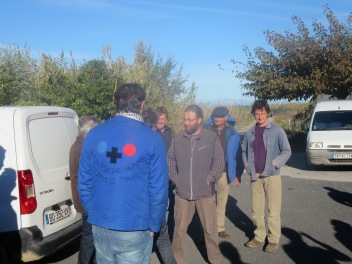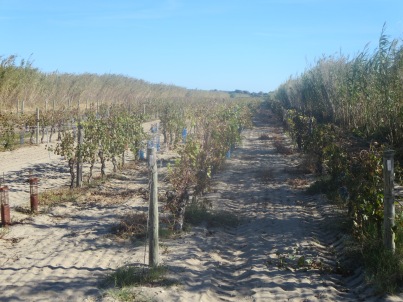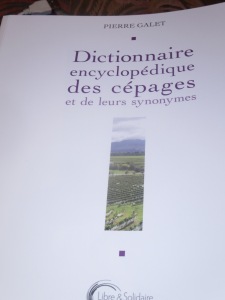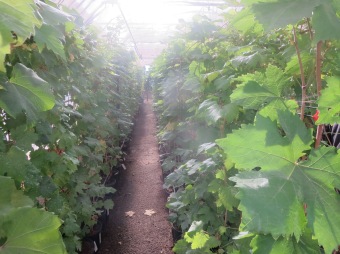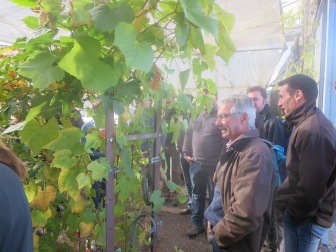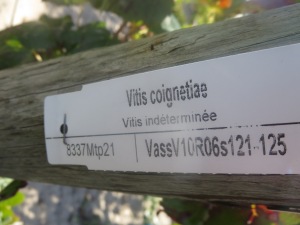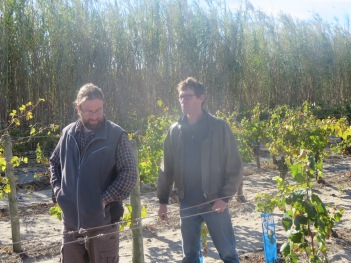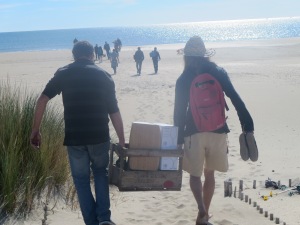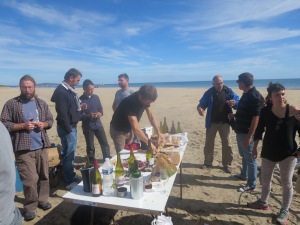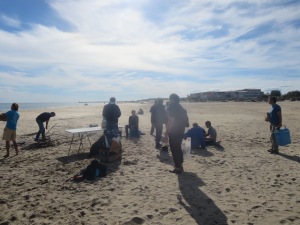
Two days at RAW London, the natural wine fair which has become part of the establishment with fairs now taking place around the world. Isabelle Legeron’s work in organising the fairs as well as her excellent book ‘Natural Wine’ and other media work has helped boost the reputation of winemakers who work organically, biodynamically and naturally and she deserves much credit.
In a way that success is a two edged sword, Sunday afternoon’s public session was very crowded and parts of the The Store were very hot, not the best tasting conditions. Monday’s trade day was much more manageable and I was able to get to almost all the producers I had shortlisted. I shall be commenting on some of those in the next article, however, I wanted to give some general impressions first.

Simon Woolf interviewing Isabelle Legeron
Perhaps it was the fact that I spent a bit of time and lunch with Simon Woolf that orange or amber wines were to the fore of my RAW experience. Seemingly every producer is working with skin contact wine, some have been doing so for generations, some for years, some making their first experiments. Simon’s book ‘Amber Revolution’ is one of the best written wine books of recent years and I highly recommend it. As for the wines themselves, well they varied greatly. Once again I was struck by the success of skin contact wines using aromatic varieties which seem to add extra layers of aroma and flavour compared to others. Successful examples here included Riesling (Domaine Brand in Alsace), Gewurztraminer (Brand and the Alto Adige producer Grawü) and Silvaner (Franken producer Weigand). Make no mistake orange wines are here to stay.
Hybrids and cross bred grapes are gathering some attention in the wine world with climate change and disease resistance amongst the reasons for their cultivation. It was interesting to taste a few examples here notably two examples of Souvignier Gris. This grape is a cross of Cabernet Sauvignon and Bronner, the latter a white grape produced from hybrids Merzling and GM6494 (a romantic name if ever there was one). Slovenian producer Batic and Alto Adige’s Thomas Niedermayr both had examples (they were unaware of each other’s bottles until I told them). The results were excellent in both cases, creamy but fresh white wine with plenty of good aroma and flavour. This is certainly an area of winemaking which will be interesting to see unfold.
Niedermayr wines to the left, the left bottle is Souvignier Gris, a photo showing its pink grapes is in front. The Batic example is the white bottle.
The growth of quality winemaking in Central and Eastern Europe has been well documented, the evidence was clear once again at RAW. Austria has been a source of excellent wine for a few years now, Georgia too. Add in the Friuli / Slovenia region for orange wines, Czech, Hungarian and Swiss producers too. There were some lovely wines and the story behind wineries such as the Czech Jaroslav Osicka is inspiring, a family working in organic ways, determined to do things right whilst struggling against bureaucracy and attitudes from those in authority and colleagues too. Osicka, Batic, Balog, Natenadze’s were all wineries which offered good wines from these regions and which I would recommend. My friend David Crossley regularly reports upon the growth of such wines and I recommend his report on Osicka and others here.
 Miha Batic with Jaroslav Osicka
Miha Batic with Jaroslav Osicka
The continued success of natural wine’s big guns continues unabated. The likes of Radikon, Gravner and Cornelissen attracted large crowds on both days, rightly so. These are fascinating, unique wines. Cornelissen wines have become more consistent to my taste in recent vintages and they were showing very well. In the hunt for the new let’s not overlook the established stars.
Similarly I was struck by how much classic wine regions shone for me at RAW. My favourite ranges of wines were probably the Burgundies of AMI and the Saint Emilion wines of Château Le Puy and Château Meylet. I would not have imagined that to be the case even a year ago. These classic regions have a new wave of producers, such as AMI, who are working in organic, biodynamic and natural ways and the results are great. Expensive, perhaps, but delicious.
Finally, fairs such as RAW always throw up surprises and new discoveries. I had no intention of visiting Sicily producer Marino but an empty table on a crowded day proved fortuitous. I really liked the two wines of this small domaine, the Turi Bianco in particular. As is so often the case lovely people make lovely wines, a young couple deserving of success. I was pleased to see David liked them too in his report. Other pleasant surprises: the Welsh producer Ancre Hill, with a terrific Orange Wine (of Albarino grapes) and two PetNats; a new Languedoc producer to me, Mas Lasta with fresh, flavoursome wines including a white wine made from Grenache Noir; the excellent Banyuls wines of Domaine Du Traginer.
By Monday afternoon my tasting abilities were exhausted. As usual there were regrets at missing one or two producers but I had enjoyed myself and came away confident that RAW winemaking is in a healthy place with new, exciting producers and ideas emerging to join the wealth of talent already established. I shall be sharing more of my particular findings next time.















